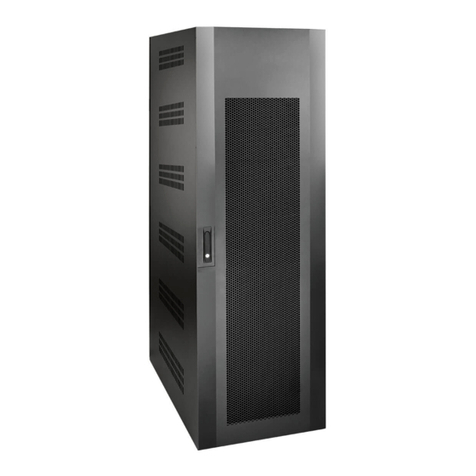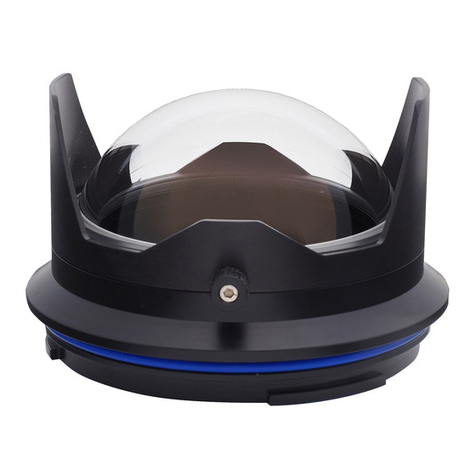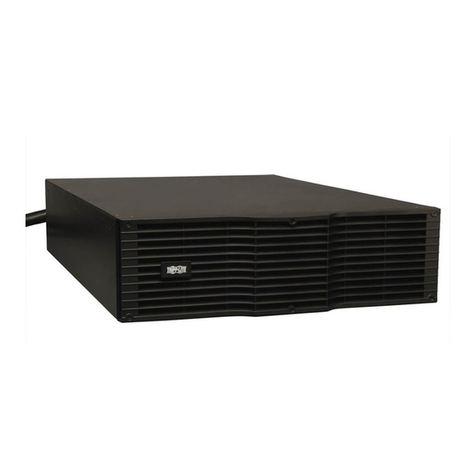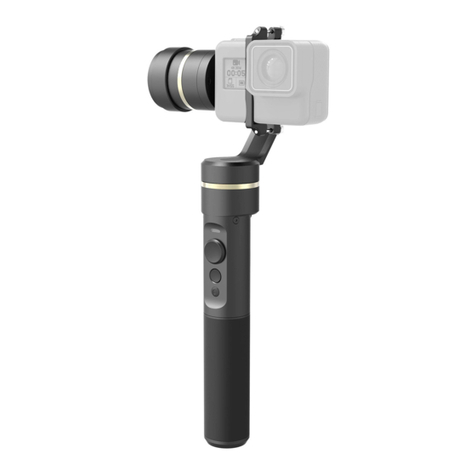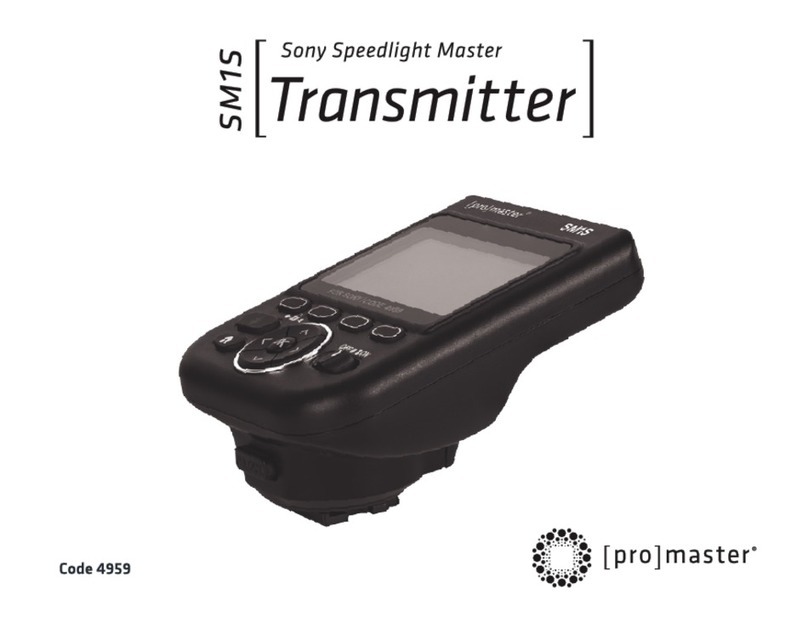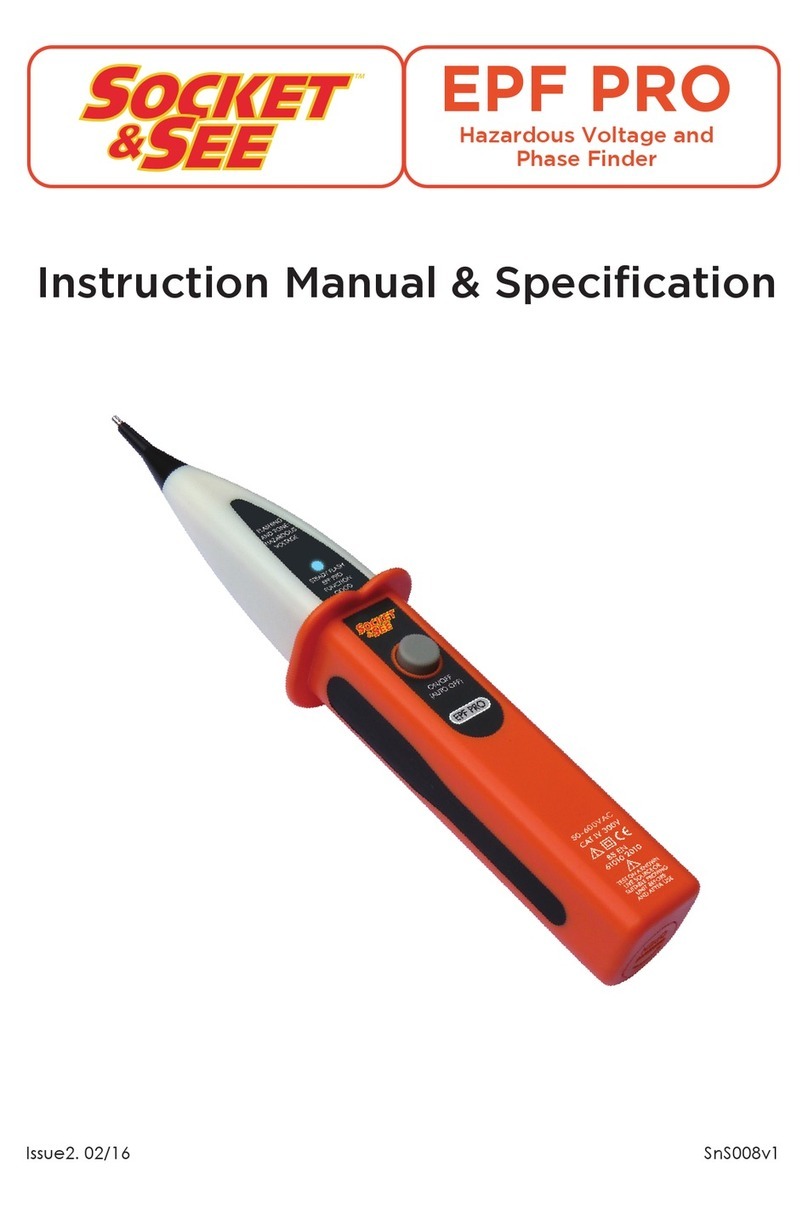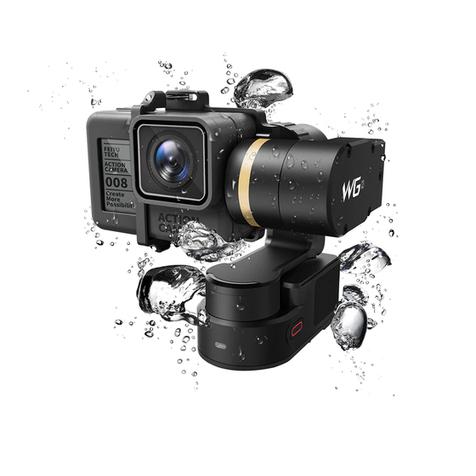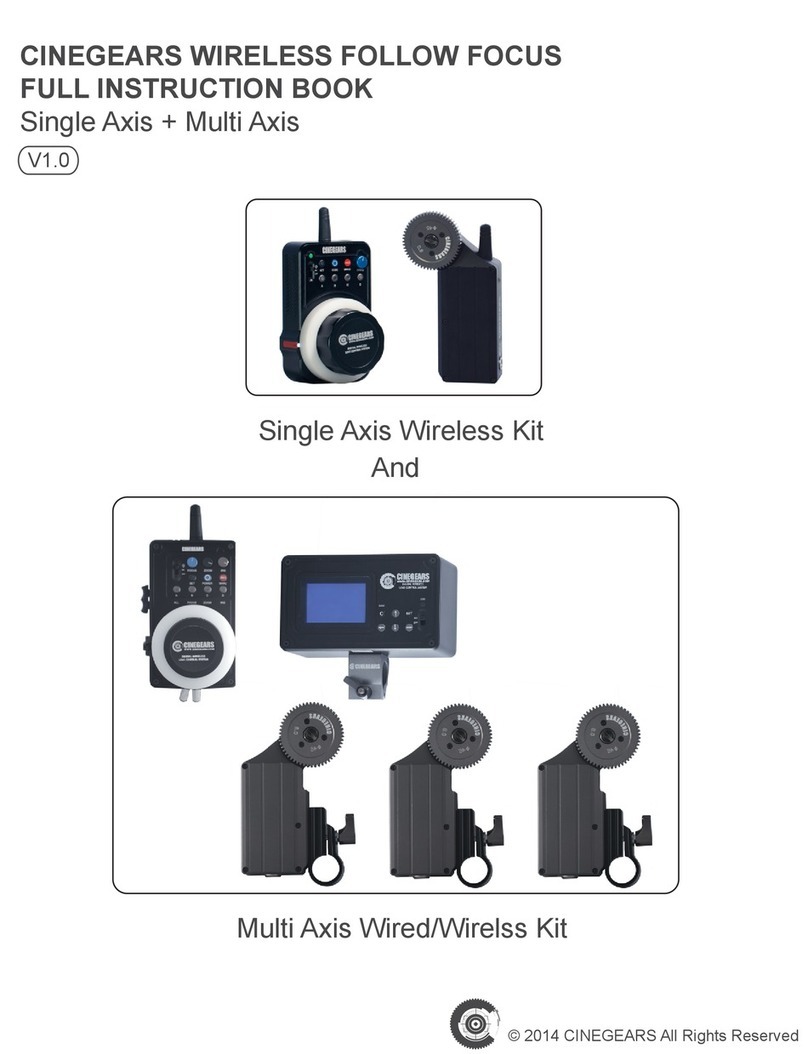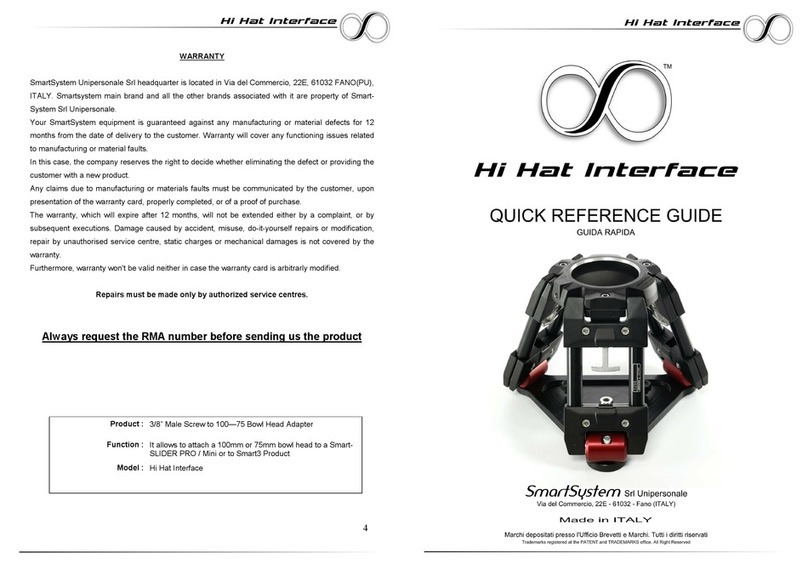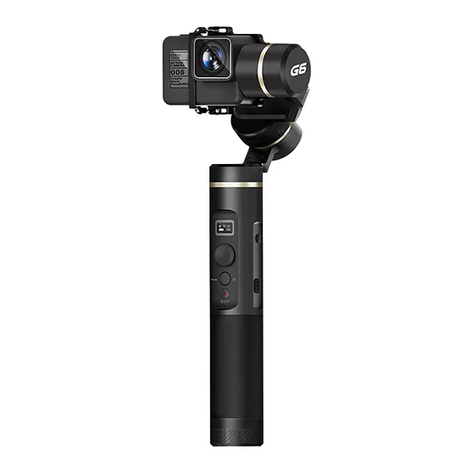Deka 8A User manual

8A & 8G BATTERY INSTALLATION
AND OPERATING INSTRUCTIONS
SAFETY PRECAUTIONS
Although all valve-regulated cells have the electrolyte
immobilized within the cell, the electrical hazards associ-
ated with batteries still exists. Work performed on these
batteries should be done with the tools and the protective
equipment listed below. VRLA battery installations should
be supervised by personnel familiar with batteries and
battery safety precautions.
WARNING: Risk of fire, explosion, or burns. Do not
disassemble, heat above 40°C, or incinerate.
Protective Equipment
Although VRLA batteries can vent or leak small amounts
of electrolyte, electrical safety is the principle but not
the only concern for safe handling. Per IEEE 1188 recom-
mendations, the following minimum set of equipment for
safe handling of the battery and protection of personnel
shall be available:
• Safety glasses with side shields, or goggles, or face
shields as appropriate. (Consult application specific
requirements)
• Electrically insulated gloves, appropriate for the installation.
• Protective aprons and safety shoes
• Portable or stationary water facilities in the battery
vicinity for rinsing eyes and skin in case of contact with
acid electrolyte.
SAFETY PRECAUTIONS (con’t)
• Class C fire extinguisher
• Acid neutralizing agent.
• Adequately insulated tools (as defined by ASTM F1505
“Standard Specification for Insulated and Insulating
Hand Tools”).
• Lifting devices of adequate capacity, when required.
Procedures
Consult User Manual of specific application for
additional Safety & Operating requirements.
The following safety procedures should be followed
during installation: (Always wear safety glasses with
side shields or face shield goggles when working on
or near batteries.)
1. These batteries are sealed and contain no free electrolyte.
Under normal operating conditions, they do not present any
acid danger. However, if the battery jar or cover is damaged,
acid could be present. Sulfuric acid is harmful to the skin
and eyes. Flush affected area with water immediately
and consult a physician if splashed in the eyes. Consult
SDS for additional precautions and first aid measures.
Consult SDS for additional
precautions and first aid measures.
SDS sheets can be obtained at
www.eastpennmanufacturing.com
2. Prohibit smoking and open flames, and avoid arcing
in the immediate vicinity of the battery.
®
This manual is intended to be a guide to optimize battery performance for multiple cyclic & float applications. Consult applicable
User Manuals for additional parameters for specific systems. This manual is not intended for SLI or Vehicle related applications.
Vehicle / Equipment Owner’s Manual should be followed for SLI & Vehicle related applications.
IN REFERENCE TO THIS MANUAL:
- “Battery” is defined as an individual 12 or 6 volt unit.
- “Battery string” is defined as a series connected
electrical system comprised of batteries (individual
12 or 6 volt units).

EAST PENN MFG. CO., INC. – Proprietary. No part of this document may be copied, reproduced or disclosed electronically or
mechanically, without written permission from the company. All data subject to change without notice.
EAST PENN MFG. CO., INC. – Proprietary. No part of this document may be copied, reproduced or disclosed electronically or
mechanically, without written permission from the company. All data subject to change without notice.
2
SAFETY PRECAUTIONS (con’t)
3. Do not wear metallic objects, such as jewelry, while
working on batteries. Do not store un-insulated tools in
pockets or tool belt while working in vicinity of battery.
4. Keep the top of the battery dry and clear of all tools and
other foreign objects.
5. Provide adequate ventilation (per IEEE standard 1187
and / or as regulated by Federal, State and Local
codes) and follow recommended charging voltages.
6. Never remove or tamper with pressure relief valves.
Warranty void if vent valve is removed.
7. Inspect all flooring and lifting equipment for functional
adequacy.
8. Adequately secure battery, racks or cabinets to the floor.
9. Connect support structures to ground system in accor-
dance with applicable codes.
STORAGE / REFRESH
Batteries should be installed, and float charged upon de-
livery. If batteries are to be stored, the below requirements
shall be followed.
1. Batteries shall be stored indoors in a clean, level, dry, cool
location.
2. Store, charge, and ship in vertical position only.
3. Recommended storage temperature is 50°F (10°C) to
77°F (25°C). Acceptable storage temperature is 0°F
(-18°C) to 90°F (32°C).
4. The batteries shall be given a refresh charge at regular
intervals as detailed below:
0°F(-18°C) to 77°F (25°C)
Batteries shall be charged by the “battery charge date”
marked on pallet.
Successive recharges shall be performed every 6 months.
78°F (26°C) to 90°F (32°C)
Battery voltage readings shall be taken monthly. Batteries
must be given a refresh charge within 3 months from date
of receipt or if any battery voltage falls below 12.72 volts
per battery (6.36V of 6V battery), whichever occurs first.
Successive refresh charges shall be performed every 3
months.
STORAGE / REFRESH (con’t)
5. Whenever a refresh charge is required, it’s important that
all batteries to be installed in the same series string re-
ceive a charge at the same time to ensure continuity once
placed in their intended application.
6. Each battery shall be charged for 24 hours at a constant
voltage equal to 14.40 volts per battery (7.20V for 6V
battery). To ensure the batteries are fully charged within
24hrs, the charger used for this refresh charge must have
the capacity to provide at least the minimum charge cur-
rent specification and not exceed the maximum charge
current for the given battery type (model), as called out in
Appendix D.
7. All requested information on “Refresh Record Form” in
Appendix A should be completed for each refresh charge.
8. Batteries shall not be stored beyond 12 months. Storing
beyond 12 months will affect warranty.
9. If the storage / refresh requirements cannot be met, con-
tact East Penn Reserve Power’s Product Support group
for alternate instructions.
INSTALLATIONS
General
Caution should be taken when installing batteries to
insure no damage occurs. The battery string cabinet,
tray, rack, etc. shall be inspected for sharp edges that
could cause damage to the battery casing. Batteries
shall not be dropped, slid, placed on rough or uneven
surfaces such as tray lips or grated flooring. Mishandling
of batteries could result in equipment damage or human
injury. East Penn will not be liable for damage or injury
as a result of mishandling or misuse of the product.
Grounding
When grounding the battery string, proper techniques
should be applied per electrical standards, such as
NEC and/or local codes, as well as User Manual of
specific application.
®
FOR ANY OTHER INSTALLATION ORIENTATION, THE PRODUCT WILL NOT BE WARRANTED.
DEKA 8A & 8G BATTERIES ARE TESTED AND APPROVED TO BE
INSTALLED AND OPERATED IN THEIR UPRIGHT POSITION.
Terminals – Upright Position Terminals – Upright / Front Position
TOP TERMINAL BATTERY FRONT TERMINAL BATTERY

3
BATTERY ASSEMBLY
(Always wear eye protection.)
1. Set up the batteries so that the positive post (+) of one
battery is connected to the negative post (–) of the next
battery for all series connections.
2. For future identification, individual batteries should be
numbered in electrical connection sequence, beginning
with number one (1) at the positive end of the battery
string.
3. All battery electrical contact surfaces shall be cleaned
by rubbing gently with a non-metallic brush or pad be-
fore installing connectors. Oxide inhibitor grease can be
used but is not required. Only approved oxide inhibitor:
No-Ox-ID “A” from Sanchem, Inc. should be used on ter-
minals and connectors.
4. Install all electrical connectors / cables and bolting
hardware loosely to allow for final alignment of batteries.
Torque to manufacturer recommendations.
5. After torquing, read the voltage of the battery string to
ensure the individual batteries are connected correctly.
The total voltage should be approximately equal to the
number of batteries times the measured voltage of one
battery (when connected in series). If the measurement
is less, recheck the connections for proper voltage and
polarity.
6. Read and record connection resistance and note the
method of measurement. This helps determine a satis-
factory initial installation and can be used as a reference
for future maintenance requirements. See Appendix E,
recording forms, in the back of the manual. Clean,
remake and remeasure any connection having a resis-
tance measurement greater than 10% of the average
of all the same type of connections.
7. Battery string performance is based on the output at the
battery terminals. Therefore, the shortest electrical con-
nections between the battery string and the operating
equipment results in maximum total system performance.
Do not select cable size on current carrying capability
only. Cable size should not provide a greater voltage
drop between the battery string and operating equip-
ment than specified. Excess voltage drop will reduce the
desired support time of the battery string.
SYSTEM OPERATION
State of Charge
Battery state of charge can be determined by measuring
the open circuit voltage. Consult the below table.
®
SYSTEM OPERATION (con’t)
Charging
Consult Charger User Manual of specific application
for Safety and Operating requirements.
For cyclic applications it is important that the bat-
tery(ies) be charged fully after each discharge. It is
recommended that 108% to 115% of the Ah (Amp
Hour) capacity removed from the battery(ies) be re-
placed after each
discharge. This additional Ah is to compensate for
any efficiency losses between the battery charger and
the battery(ies)
Charge Voltage
For both 8A & 8G batteries the following voltage set-
tings should be followed:
Charge / Absorption / Equalize
13.80V to 14.60V @ 77°F (25°C)
Float / Standby
13.50V +/- .06 @ 77°F (25°C)
The charger must be able to maintain the battery string
voltage within ± 0.5% of the desired level at all times.
Note: Divide values in half for 6-volt battery(ies).
TEMPERATURE COMPENSATION
Battery voltage should be adjusted for ambient
temperature variations.
3mV per °C (1.8°F) per cell
18mV per 12V battery
9mV per 6V battery
For temperatures above 77°F (25°C) subtract and
for temperatures below 77°F (25°C) add.
Consult Voltage Compensation Chart in
Appendix B for temperature compensation voltage
maximum and minimum limits.
The average battery operating temperature should not
exceed 95°F (35°C) and should never exceed 105°F
(40.5°C) for more than an eight-hour period. Operating
at temperatures greater than 77°F (25°C) will reduce the
operating life of the battery. If operating temperatures
are expected to be in excess of 95°F (35°C), contact
East Penn for recommendations.
Discharging at temperatures less than 77°F (25°C) will
reduce the capacity of the battery.
Charge Current
To properly determine the amount of charge current re-
quired the following variables are to be considered:
• DoD (Depth of Discharge)
• Temperature
• Size & efficiency of the charger
• Age and condition of battery(ies)
Maximum charge current should be limited to 30% of the
C20 Ah rate for the battery(ies) being used in the battery
string.
Example: 8G24 C20 rate – 73.6Ah
Max. recharge rate: 73.6Ah x 0.3 = 22.1A
Consult Charging Current vs Charging Time chart
in Appendix C as a guide line to determine recharge
time from 0% to 90% state of charge at an initial
charge current.
State of Charge vs. Open Circuit Voltage*
% Charge Gel AGM
100 12.85 or higher 12.80 or higher
75 12.65 12.60
50 12.35 12.30
25 12.00 12.00
0 11.80 11.80
NOTE: Divide values in half for 6-volt battery(ies)
*The “true” O.C.V. of a battery can only be determined
after the battery has been removed from the load
(charge / discharge) for 24 hours.

4
®
TEMPERATURE COMPENSATION
(con’t)
Discharge Voltage Curve
To estimate battery voltage during a constant current
discharge at various DoD (Depth of Discharge) consult
chart Discharge Voltage Curve in Appendix B.
NOTE: Battery voltage can vary depending on
temperature, age, and condition of battery.
BATTERY OPERATION
Battery operating temperature will effect battery string
capacity and operating life.
Temperatures greater than 77°F (25°C) will reduce the
operating life of the battery. For every 13°F (7°C) in-
crease in operating temperature above 77°F (25°C), the
warranty period will be proportionally reduced by 50%
as shown below:
The average cell operating temperature should not ex-
ceed 95°F (35°C) and should never exceed 105°F (40.5°C)
for more than an eight-hour period. If operating tem-
peratures are expected to be in excess of 95°F (35°C),
contact East Penn for recommendations.
Discharging at temperatures less than 77°F (25°C) will
reduce the capacity of the battery.
Batteries [cells] must not be continuously operated
below 50°F (10°C). If operating temperatures are
expected to be less than 50°F (10°C), contact East
Penn for recommendations.
The battery string must be located in a manner that the in-
dividual cells do not vary by more than 5°F (2.8°C) between
the lowest and highest individual cell temperatures.
RECTIFIER RIPPLE VOLTAGE
Frequency
Ripple that has a frequency greater than 667Hz (dura-
tion less than 1.5ms) is acceptable, unless it is causing
additional battery heating.
Ripple that has a frequency less than 667Hz (duration
greater than1.5ms), must meet the following voltage
specification to be acceptable.
Voltage Specification
Ripple voltage shall be less than .5% peak to peak of
the manufacturer’s recommended string voltage.
Failure to comply can void the warranty.
RECORD KEEPING
Voltages, Temperatures & Ohmic Readings
Record keeping is an important part of battery mainte-
nance and warranty coverage. This information will help
in establishing a life history of the battery string and
inform the user if and when corrective action needs to
be taken. Consult Battery Maintenance Report (Pg.8 –
Appendix E).
While it is acceptable to operate at temperatures less
than 77°F (25°C), it will require longer charging time to
become fully recharged. Also, the capacity will be less
at operating temperatures below 77°F (25°C).
After installation and when the battery string has been
on float charge for one week, the following data should
be recorded:
1. Battery string voltage at battery terminals while battery
is on float charge.
2. Charger voltage at charger panel meter.
3. Individual battery float voltages.
4. Ambient temperatures within area of battery string.
5. Terminal connections should be checked to verify that
the installer did torque all connections are properly
torqued. Micro-ohm readings should be taken across
every
connection. Refer to meter manufacturer’s instructions
for proper placement of probes. If any reading differs
by more than 20% from its initial installation value,
re-torque the connection, to 100 ± 5 in lb
(11.3 ± .5 newton meters) for proper torque values.
If reading remains high, clean contact surfaces ac-
cording to Step 2 under Battery Assembly.
Failure to maintain proper records including
information as detailed above may result in
voiding any applicable warranty.
Acceptance Testing
Each battery should be at 100% State of Charge prior
to performing an acceptance test on the battery system.
To ensure the batteries are fully charged the following
charge schedule should be followed.
Batteries should be charged at the equalization rate
of 14.40 volts per battery (7.20V for 6V battery) for 24
hours. Temperature compensated charging parameters
shall be applied as detailed in “Voltage Compensation
Chart” in Appendix B of this manual.
To ensure the batteries are fully charged within 24hrs;
the charger used for this charge must have the current
equal to the maximum charge current for the given
battery type (model), as called out in Appendix D of
this manual.
If these requirements cannot be met, contact East Penn
Reserve Power’s Product Support group for alternate
instructions.
Upon completion, the charge voltage should be
lowered to the float voltage of 13.50 volts per battery
(6.75V for 6V battery) for a minimum period of 72 hours.
Reference: IEEE 1188-2005 Section 7.2 for additional
acceptance test requirements.
Operating Temperature Proportional
Percentage (%)
of Life
°F °C
77 25 100%
81 27 80%
87 30 60%
90 32 50%

5
®
Upon completion of the above charge, the desired
acceptance test can be performed.
NOTE: There shall be no discharges of any duration
between the start of the equalization and the comple-
tion of the float period. If a discharge does occur, the
charging regime detailed above shall be repeated.
Upon completion of the acceptance test, the battery
system should be placed on float charge at 13.50 volts
per battery (6.75V for 6V battery) to restore the battery
to its’ rated capacity. Batteries should not require an
equalization charge once they have passed their ini-
tial acceptance test. Consult with East Penn Reserve
Power’s Product Support group before performing
additional equalizing charges on batteries that have
successfully passed their initial acceptance test.
MAINTENANCE
Always wear eye protection when working on or near
batteries. Keep sparks and open flames away from
batteries at all times.
Consult User Manual of specific application for
additional Safety & Operating requirements.
Annual Inspection
Depending on the application, some of the following
recommendations may not apply.
1. Conduct a visual inspection of the battery(ies).
2. Record battery and /or battery string voltage. The ac-
curacy of the DMM (Digital Multimeter) must be 0.05%
(on dc scale) or better. The DMM must be calibrated to
NIST traceable standards. Because voltage readings
are affected by discharge and recharges, for cyclic
applications, the battery(ies) must be in a fully charged
condition prior to taking readings. Batteries should be
within ± 0.30 volts (+ 0.15 volts for 6V) of the average
battery float voltage.
3. Record charger voltage at charger panel meter.
4. Record the ambient temperature.
5. Record the battery string temperature at the negative
terminal
6. Record individual battery ohmic readings.***
7. Record all interunit and terminal connection resis-
tances. Micro-ohm readings should be taken during
this inspection. If any reading is greater than 20% from
initial readings, retorque the connection. Recheck the
micro-ohm reading. If the reading remains high, clean
contact surface according to installation portion of this
manual.
*** Note: To provide accurate / consistent values,
battery(ies) must be fully charged, at same tem-
perature and probes placed at same location each
time readings are taken.
Battery Cleaning
Batteries, cabinets, and racks should be cleaned
with clean water, a mixture of baking soda and water or
East Penn Mfg. supplied battery cleaner (part # 00321
Never use solvents to clean the battery(ies).
Capacity Testing
Capacity testing is used to trend battery aging. The re-
sult of a capacity test is a calculation of the capacity of
the battery. The calculated capacity is also used to de-
termine if the battery requires replacement.
NOTE: When discharging at higher rates, extra con-
nectors may need to be added to prevent excessive
voltage drop and / or excessive temperature rise.
Should it be determined any individual battery(ies) or
cell(s) need to be replaced, contact your nearest East
Penn agent or East Penn Mfg. Co.

APPENDIX A
6
REFRESH RECORD FORM
EPM Order Number* Pallet ID Number Individual Performing Test (Full Name) Date of
Refresh Refresh Duration
Model
Number
Information Prior to Refresh Information within 1 hour of
Refresh Completion
Notes & Comments
Date
Code
Battery
Serial
Number
Open Circuit Voltage
Battery
Voltage
Reading
Charging
Current
Battery
Temperature
Battery 1
Battery 2
Battery 3
Battery 4
Battery 5
Battery 6
Battery 7
Battery 8
Battery 9
Battery 10
Battery 11
Battery 12
Battery 13
Battery 14
Battery 15
Battery 16
Battery 17
Battery 18
Battery 19
Battery 20
Battery 21
Battery 22
Battery 23
Battery 24
ALL FIELDS TO THE RIGHT OF THE CELL NUMBER ABOVE MUST BE COMPLETED
EPM ORDER NUMBER WILL APPEAR ON THE SHIPPING LABEL ON THE CARTON COVERING EACH PALLET OF BATTERIES
TO ENSURE CONTINUATION OF WARRANTY, SUBMIT FORMS TO: East Penn Mfg. Co, Inc.,

APPENDIX B
7
Voltage Compensation Chart
Note: 1. Above values based on 12-volt battery.
2. Divide above values in half for 6-volt battery.
°C Float Absorption / Regulation Equalize /
Maintenance °F
Min. Max.
>35 13.32 13.62 14.22 14.40 >95
34 13.34 13.64 14.24 14.42 93.2
33 13.36 13.66 14.26 14.44 91.4
32 13.37 13.67 14.27 14.45 89.6
31 13.39 13.69 14.29 14.47 87.8
30 13.41 13.71 14.31 14.49 86.0
29 13.43 13.73 14.33 14.51 84.2
28 13.45 13.75 14.35 14.53 82.4
27 13.46 13.76 14.36 14.54 80.6
26 13.48 13.78 14.38 14.56 78.8
25 13.50 13.80 14.40 14.58 77.0
24 13.52 13.82 14.42 14.60 75.2
23 13.54 13.84 14.44 14.62 73.4
22 13.55 13.85 14.45 14.63 71.6
21 13.57 13.87 14.47 14.65 69.8
20 13.59 13.89 14.49 14.67 68.0
19 13.61 13.91 14.51 14.69 66.2
18 13.63 13.93 14.53 14.71 64.4
17 13.64 13.94 14.54 14.72 62.6
16 13.66 13.96 14.56 14.74 60.8
15 13.68 13.98 14.58 14.76 59.0
14 13.70 14.00 14.60 14.78 57.2
13 13.72 14.02 14.62 14.80 55.4
12 13.73 14.03 14.63 14.81 53.6
11 13.75 14.05 14.65 14.83 51.8
<10 13.77 14.07 14.67 14.85 <50

8
APPENDIX C
DISCHARGE VOLTAGE CURVE
CHARGING CURRENT VS. CHARGING TIME*
BATTERY TYPE
A= 8AU1, 8GU1
B= 8G40C
C= 8A22NF, 8G22NF
D= 8G34R
F= 8A27, 8G27
G= 8A31DT, 8G30H,
8G31, 8G31DT
H= 8G5SHP
I= 8A4D, 8G4D, 8GTE35
J= 8A8D, 8G8D
K= 8AGC2, 8GGC2

9
APPENDIX D
Charge Current Limits
8A Series 8G Series
Cell Type Max. Charge
Current (A)
Min. Charge
Current (A)**
8AU1 9.6 2.9
8A22NF 16.5 5.0
8A24 23.7 7.1
8A24HEI 23.7 7.1
8A27 27.6 8.3
8A27EI 27.6 8.3
8A30H 31.5 9.5
8A30HEI 31.5 9.5
8A31DT 31.5 9.5
8AGC2 57.0 17.1
8A4D 59.4 17.8
8A8D 73.5 22.1
** = Using minimum charge current will extend recharge
time and increase risk of battery being undercharged
Cell Type Max. Charge
Current (A)
Min. Charge
Current (A)**
8GU1 31.6 9.5
8G40C 40.0 12.0
8G22NF 51.0 15.3
8G34R 60.0 18.0
8G24 73.6 22.1
8G24SS 73.6 22.1
8G27 88.0 26.4
8G30H 97.6 29.3
8G31 97.6 29.3
8G31DT 97.6 29.3
8GGC2 180 54.0
8G4D 183 54.9
8G4DEI 183 54.9
8G8D 225 67.5
8G8DEI 225 67.5
8G5SHP 115 34.5
8GTE35 196 58.9

10
APPENDIX E

11
Page Intentionally Blank
®

All data subject to change without notice. No part of this document may be copied or
reproduced, electronically or mechanically, without written permission from the company.
E.P.M. Form No. 1833 10/22 © 2022 by EPM Printed in U.S.A.
East Penn Manufacturing Co. Lyon Station, PA 19536-0147 Phone: 610-682-3263 Fax: 610-682-4781 www.dekabatteries.com
This manual suits for next models
1
Table of contents
Other Deka Camera Accessories manuals
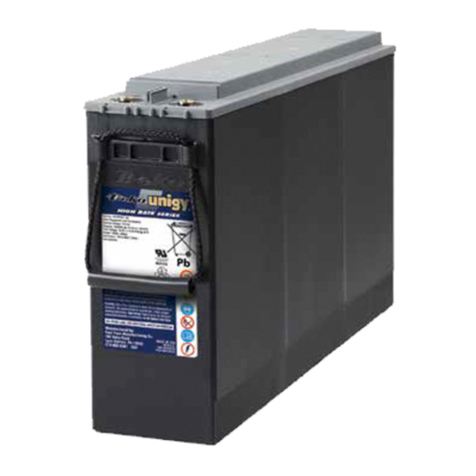
Deka
Deka Unigy I User manual
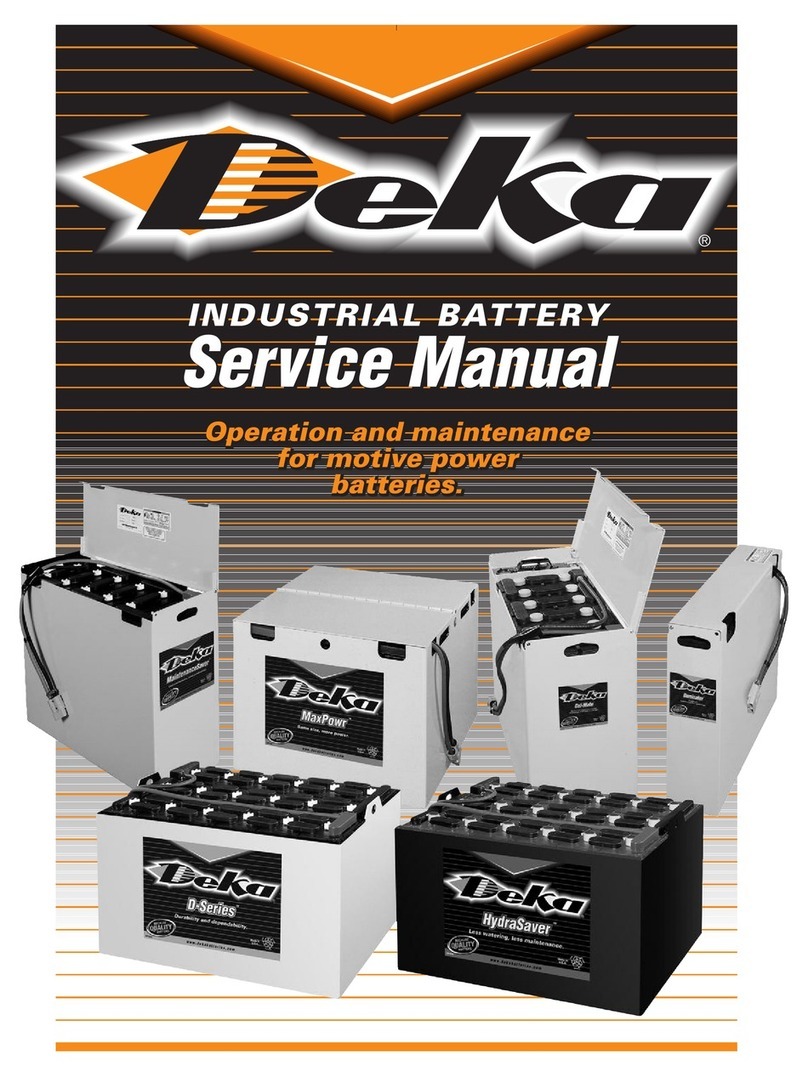
Deka
Deka Dominator Gel-Mate SVRLA G45 User manual
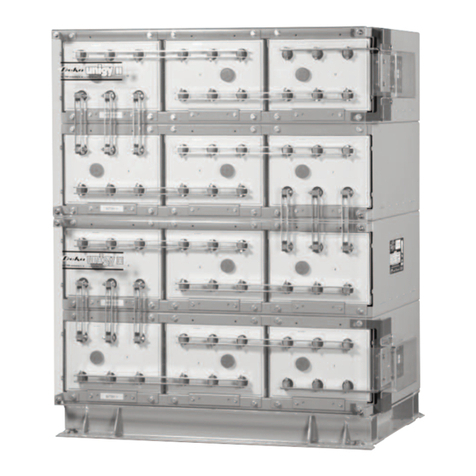
Deka
Deka Unigy II User manual
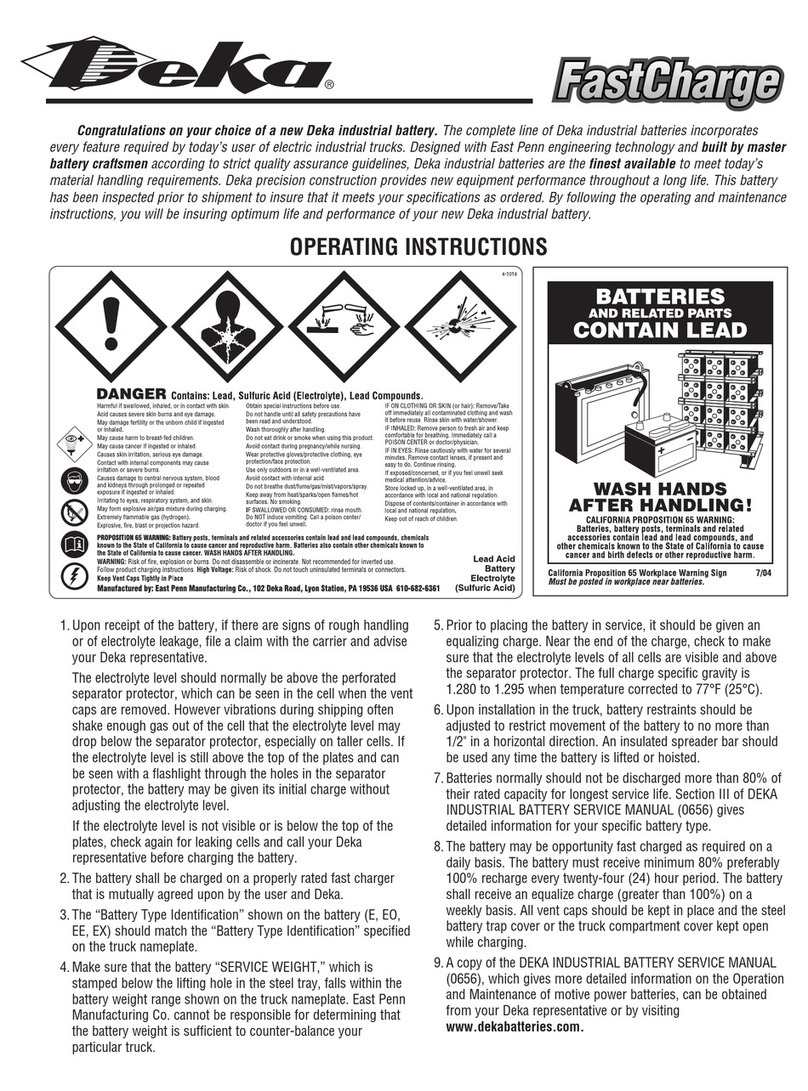
Deka
Deka FastCharge F35 User manual
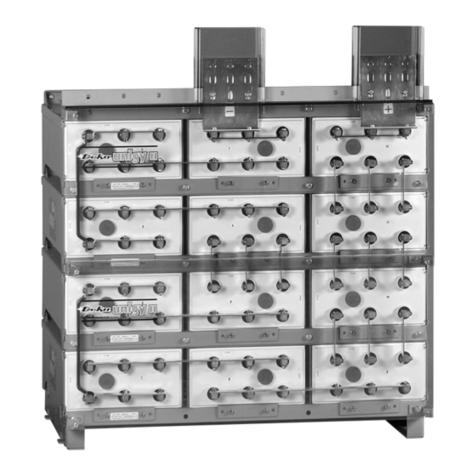
Deka
Deka unigy II SPACESAVER Non-Interlock AVR 45 AH User manual
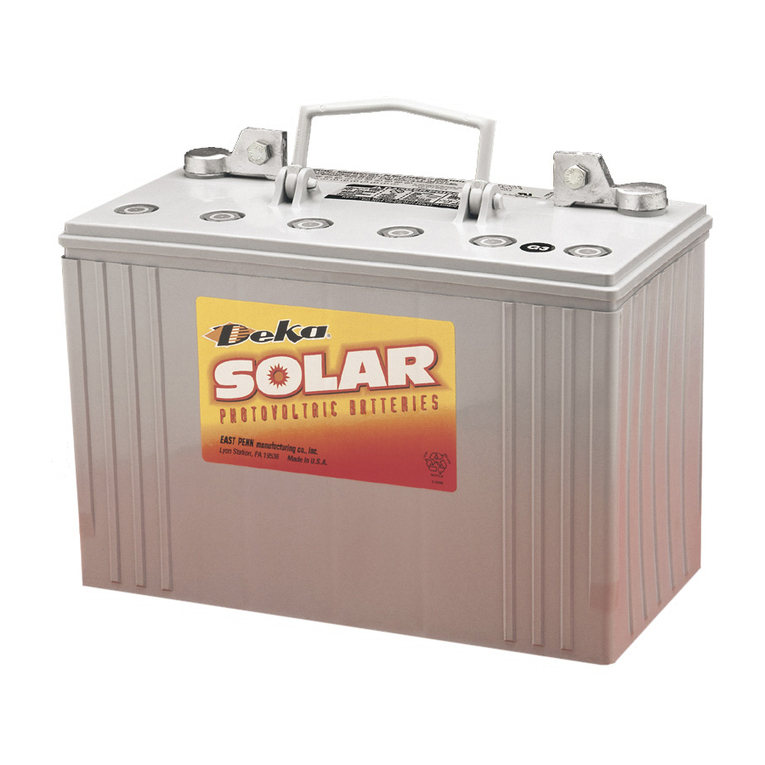
Deka
Deka SOLAR Monoblock VRLA System Installation instructions

Deka
Deka unigy I User manual
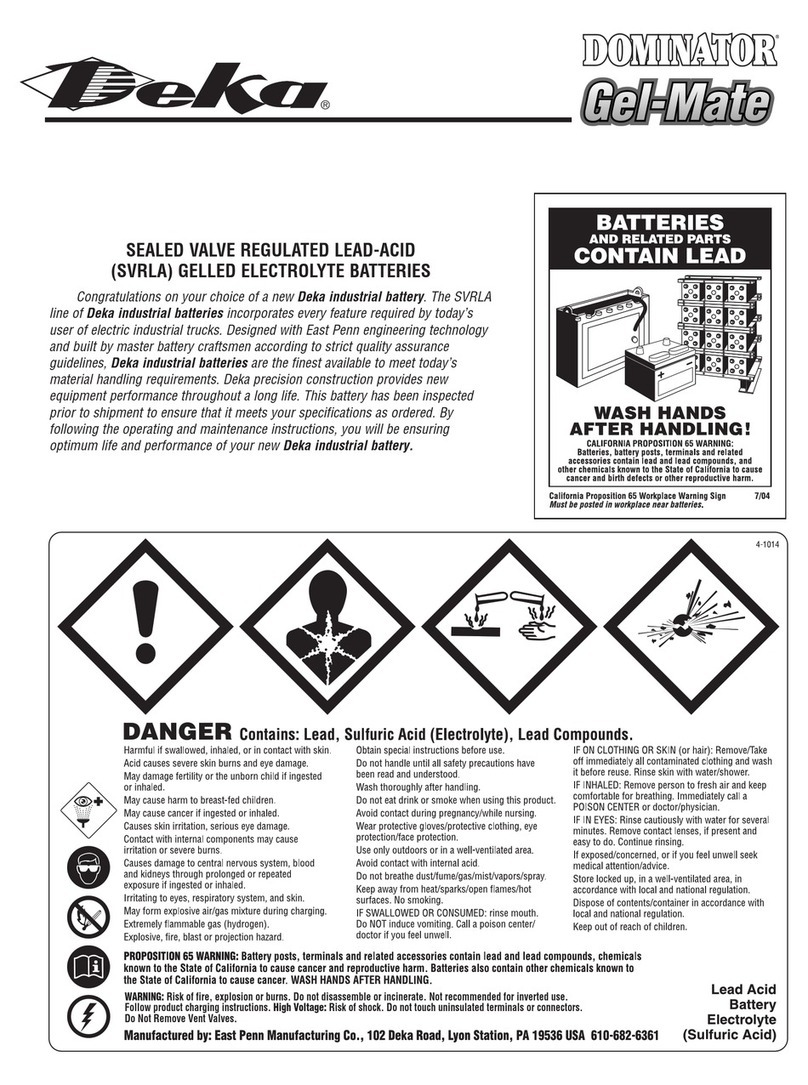
Deka
Deka Dominator Gel-Mate SVRLA G105 User manual

Deka
Deka EZ LINK D35 User manual

Deka
Deka Unigy II AVR45 Series User manual


